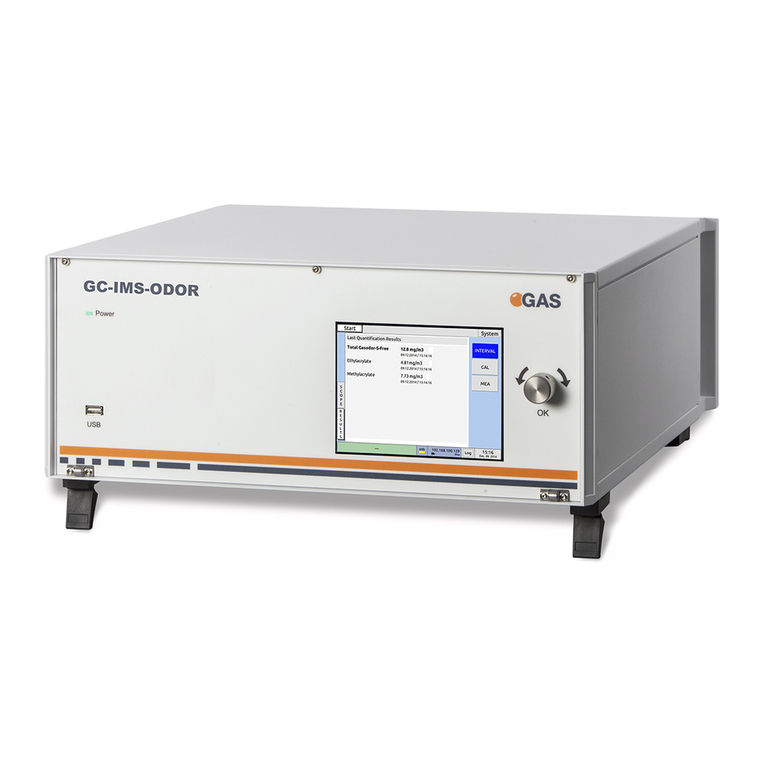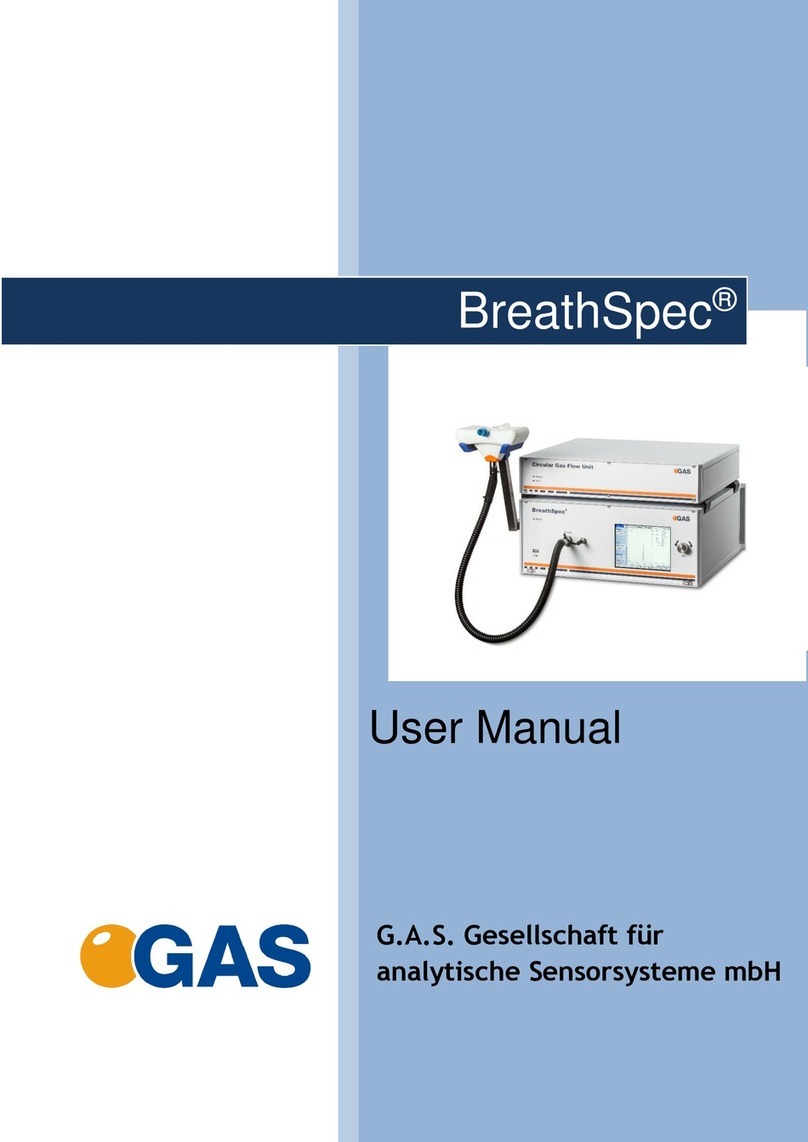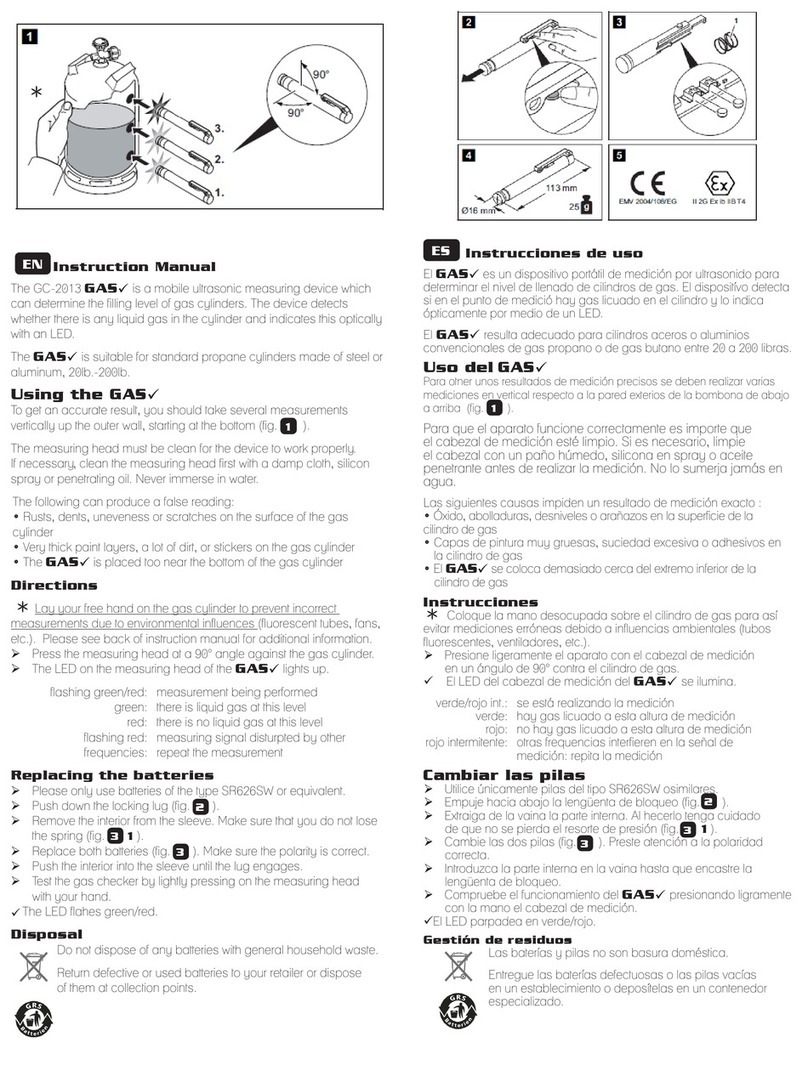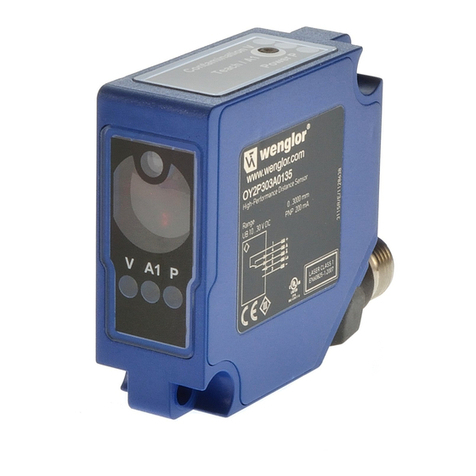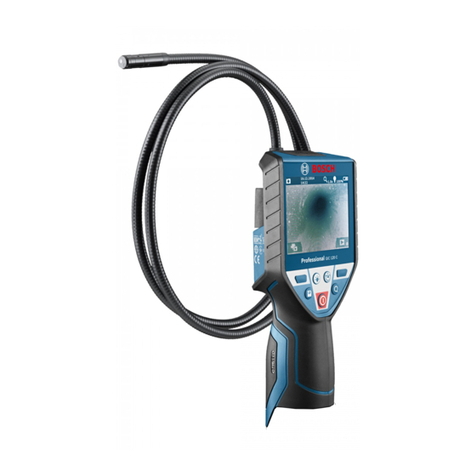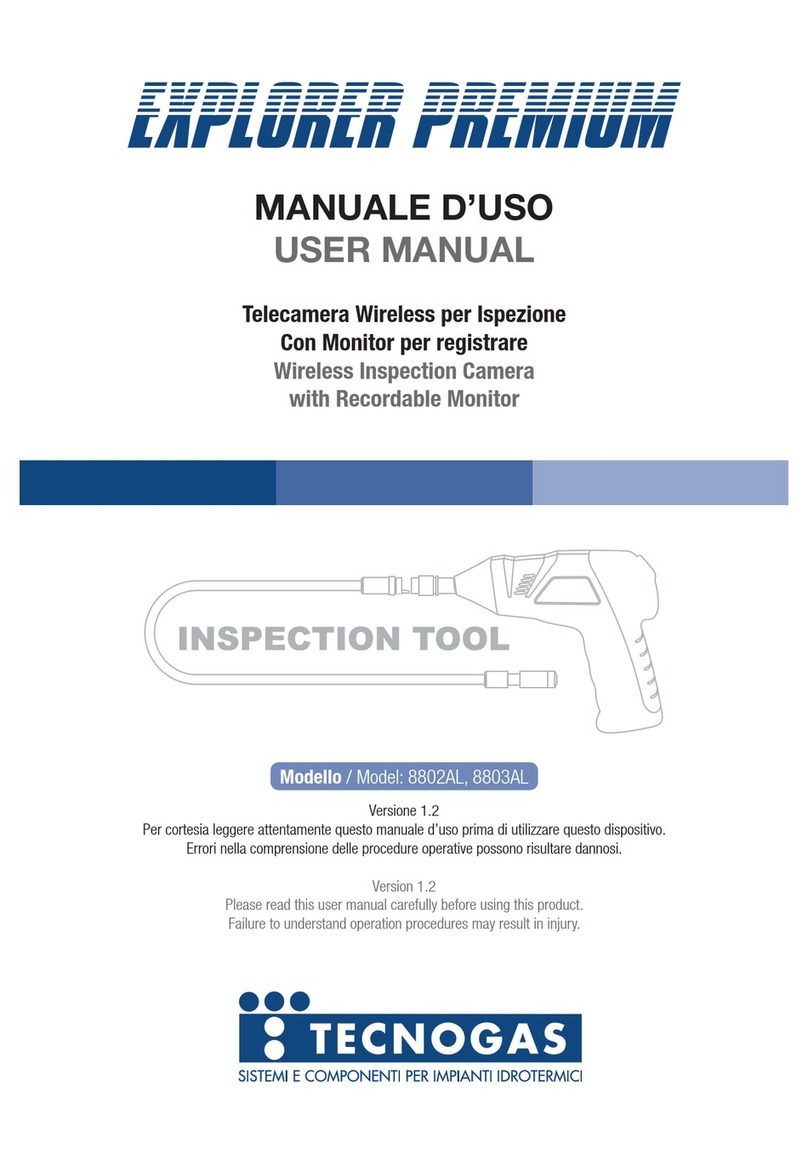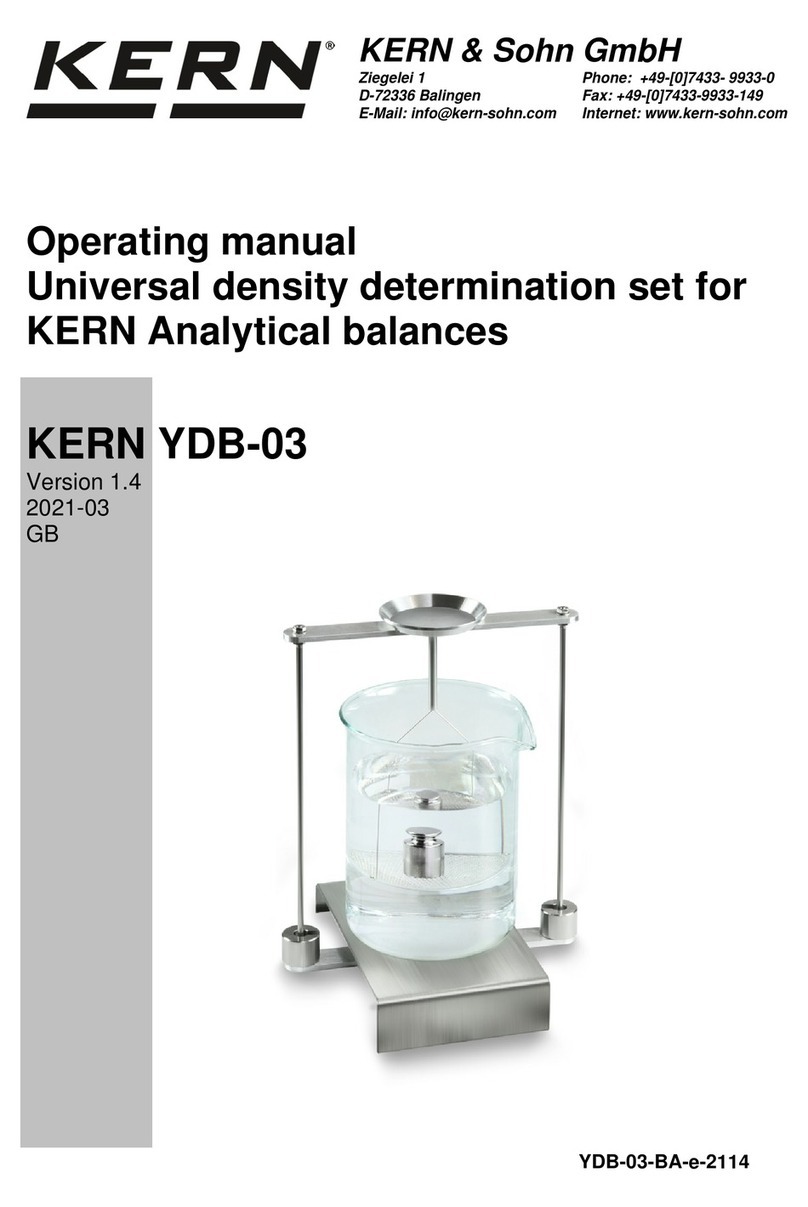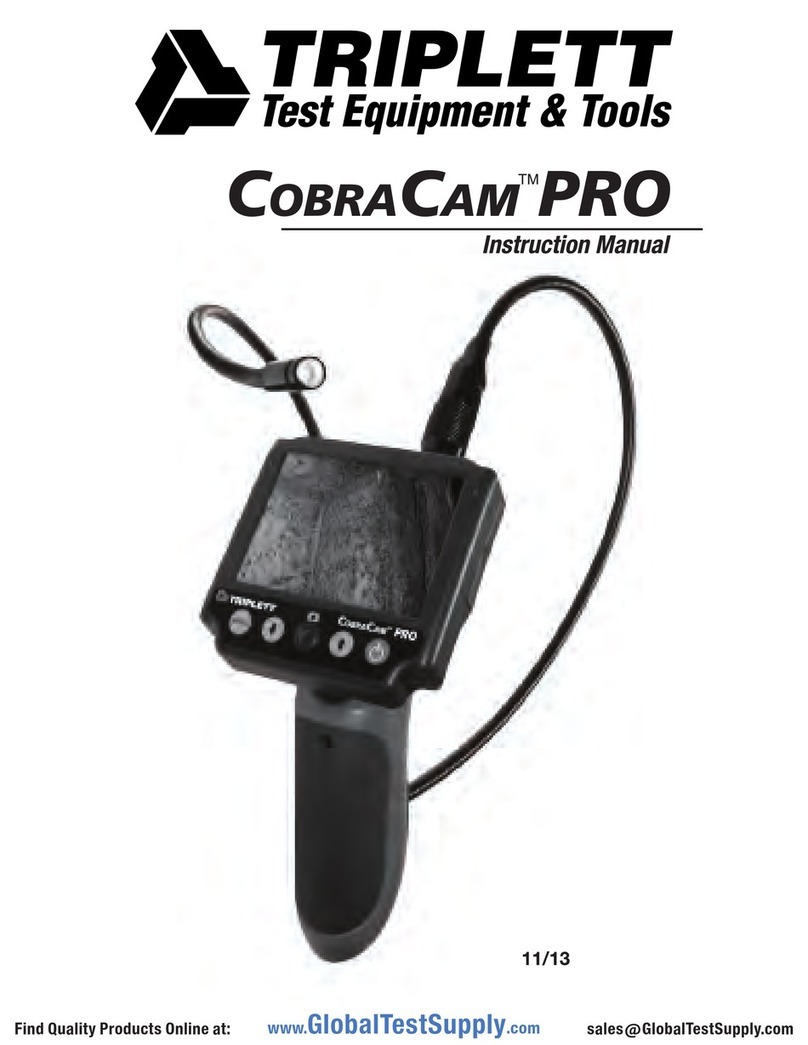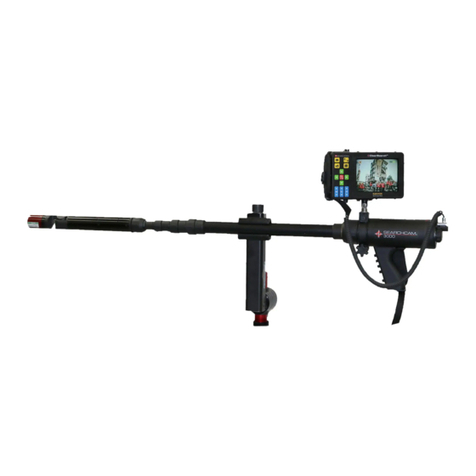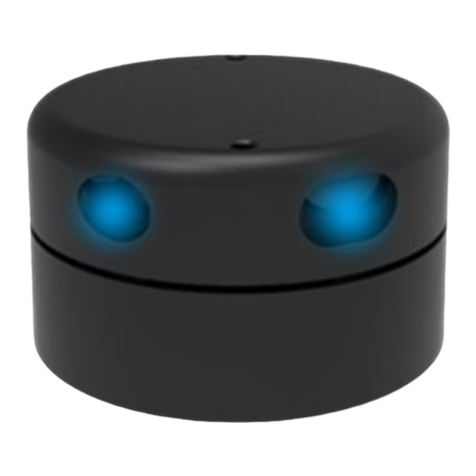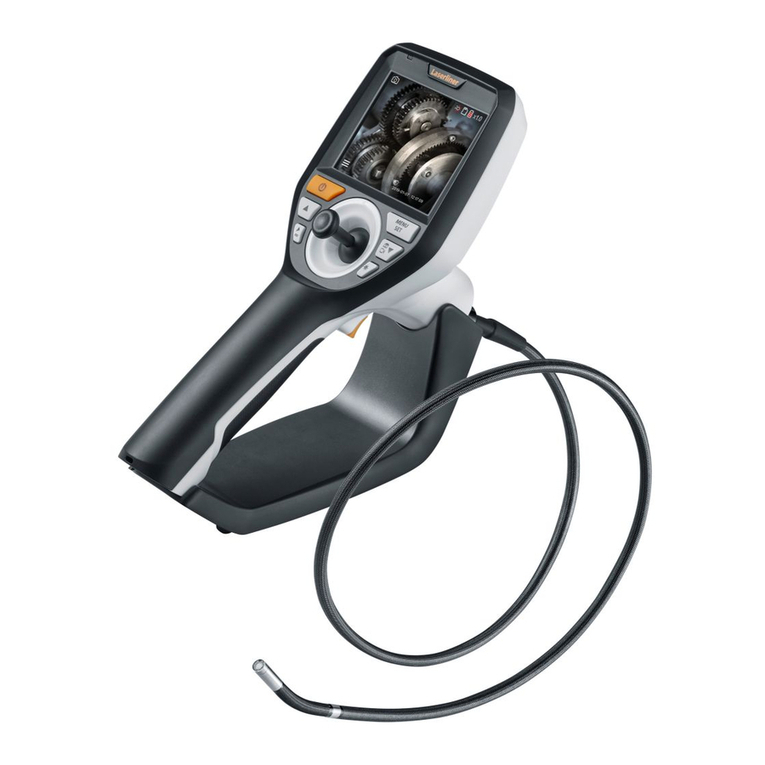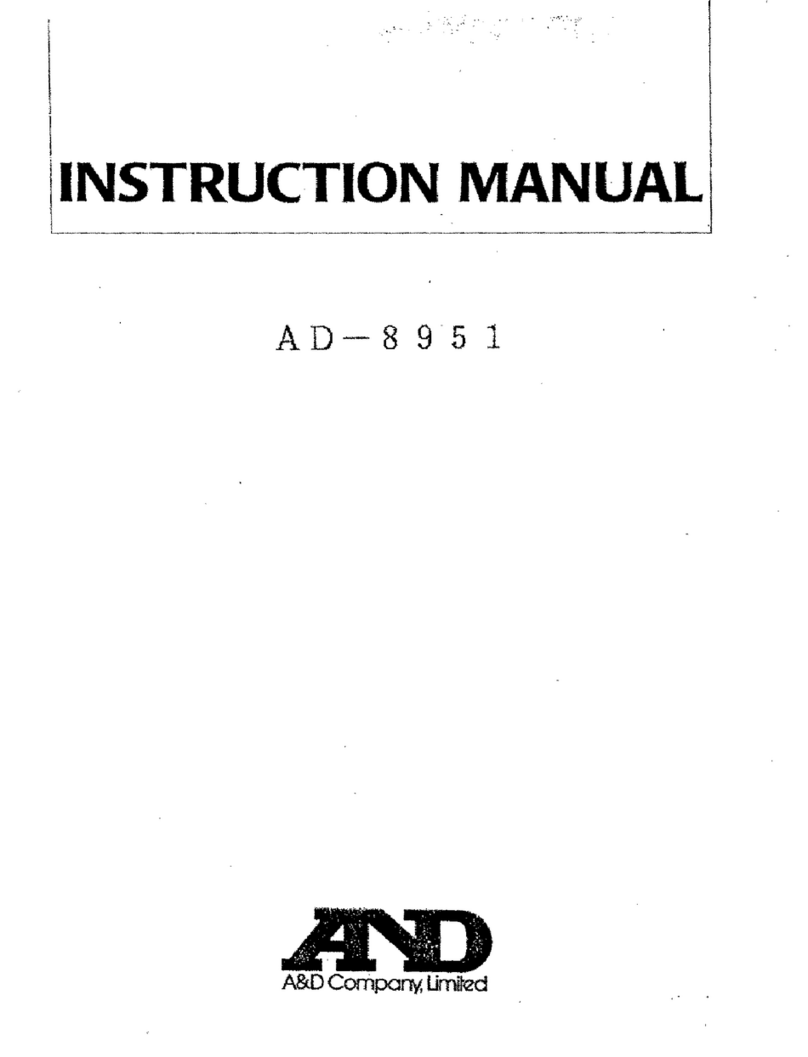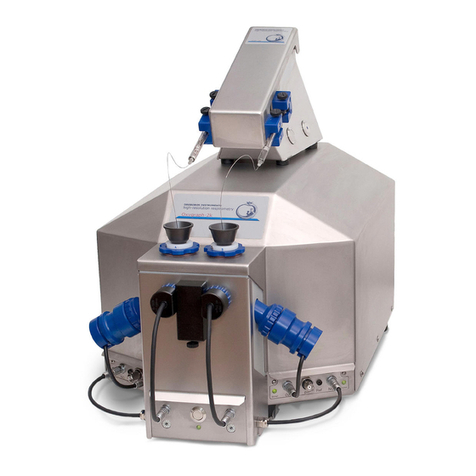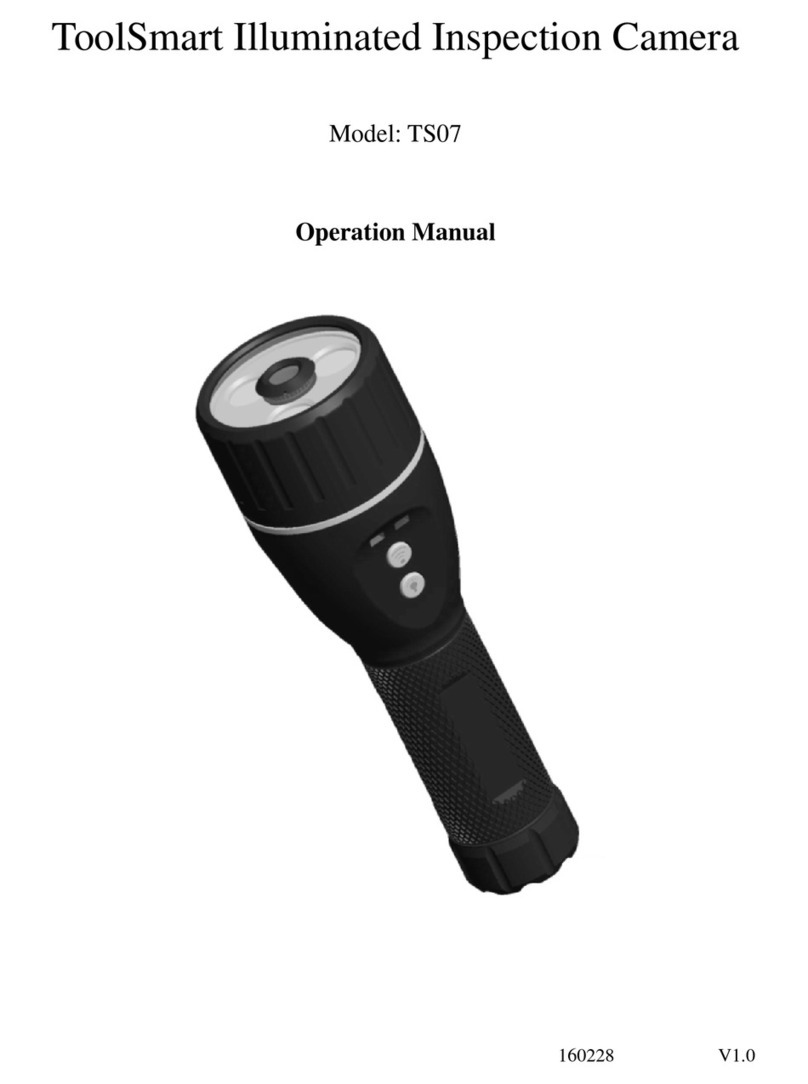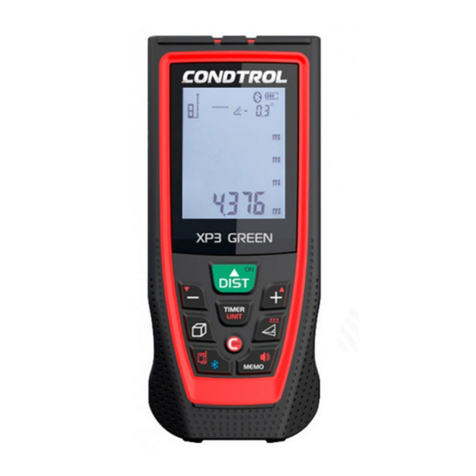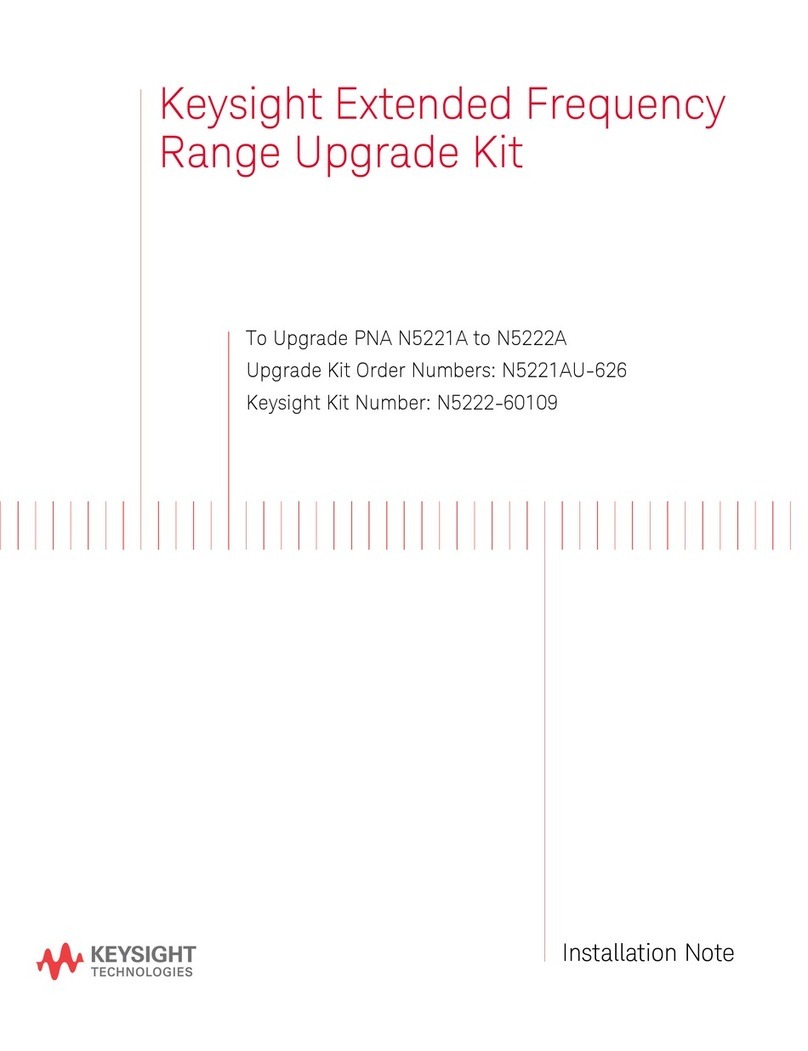GAS SF6-Aciditor User manual

Manual
SF6-Aciditor
Version 1.2

SF6-Aciditor
2
© G.A.S. Gesellschaft für analytische Sensorsysteme mbH
DortmundBioMedicineCenter
Otto-Hahn-Straße 15
D-44227 Dortmund, Germany
Phone: +49 231 / 97 42 - 65 50
Fax: +49 231 / 97 42 - 65 55
Internet: www.gas-dortmund.de
2.2.2010

SF6-Aciditor
3
1 General Information 4
1.1 Information about the Manual 4
1.2 Explanation of Symbols 4
1.3 Scope of Supply 5
1.4 Liability and Guarantee 5
1.5 Copyright 6
1.6 Return and Disposal 6
1.7 Customer Service 6
2 Transport, Packing and Storage 7
2.1 Inspection after Transport 7
2.2 Transport 7
2.3 Packing 7
2.4 Storage 7
3 Cleaning and Maintenance 8
3.1 Cleaning 8
3.2 Maintenance 8
3.3 Exchange of the sensor / Calibration 8
4 Security 9
4.1 Intended Use 9
4.2 Responsibility of the Operator 9
4.3 Requirements of the Personnel 10
4.4 Dangers 10
5 Introduction 11
5.1 WorkingPrinciple 12
6 System Operation 14
6.1 Loading of Battery 14
6.2 Insertion of the SO2-Sensor 15
6.3 Operation of the SF6-Aciditor 17
6.4 Purging of the SF6-Aciditor 19
6.5 Settings 20
6.5.1 Turn on/off beeper 20
6.5.2 Reset lifetime counter 20
6.6 Exchange of the SO2-Sensor 22
7 Technical Data 25

SF6-Aciditor
4
1 General Information
1.1 Information about the Manual
This manual describes a safe and adequate handling of the SF6-Aciditor. Following the
instructions of the indicated safety aspects and instructions as well as the national and/or
local rules and general safety regulations concerning the prevention of accidents are
absolutely imperative.
Before starting the work with the device read the manual completely and thoroughly
particularly the chapter security and respective safety references. Assure that you/the
operator comprehend the terms described.
The manual is part of the device. It has to be stored together with and next to the device at
any time.
1.2 Explanation of Symbols
Important and safety-relevant references in this manual are characterized by symbols. These
indications which are in-line with industrial safety must be respected and followed at any
time.
Information!
This symbol calls information, which are to be considered for efficient and
perfect handling of the equipment.
NOTE! Danger for real values!
This symbol indicates references, which can lead to damages,
malfunctioning and/or loss of the device.
WARNING! Danger by electric current!
This symbol marks references, which can lead to health impairments,
injuries, lasting body damages or to death due to electric current.
VERY DANGEROUS! Injury or mortal danger!
This symbol marks references, which can lead to health impairments,
injuries, lasting body damage or to death.

SF6-Aciditor
5
1.3 Scope of Supply
Assure that you have received the full scope of supply. If there is any part missing, please
contact the G.A.S.-hotline immediately.
The scope of supply consists of:
•SF6-Aciditor
•SO2-Sensor foil sealed
•Transport case
•Battery charger
•Manual SF6-Aciditor
•Instrument’s quality test report
•4 m long PTFE connecting hose with wire coating, self-closing stainless steel
couplings on both ends
1.4 Liability and Guarantee
All data and reference within this manual are compiled under the valid regulations, the state-
of-the-art as well as G.A.S. experiences of several years.
The manual has to be stored together with and close to the device at any time and
accessible to all persons, who work with it.
This manual must be read carefully before starting to work with the equipment! G.A.S. does
not overtake any liability for damage and disturbances, resulting from neglect or ignorance of
the manual’s instruction.
The text and graphics do not correspond necessarily to the scope of supply. The figures
and/or diagrams do not correspond to the yardstick 1:1.
The actual scope of supply might deviate from special (customized) equipments, the
recourse of additional order options or due to newest technical changes concerning the data
and references described herein as well as the graphic representations. For questions
please contact the G.A.S.-hotline.
G.A.S. reserves the right to realize technical changes of the product due to improvements
without explicitly mentioning them.

SF6-Aciditor
6
1.5 Copyright
The manual is confidential. It is beyond doubt exclusively made and also meant for the
personnel directly dealing with the equipment. All data, texts, designs, pictures and other
representations within this manual are protected in the sense of the copyright law and are
subject to further commercial patent rights. Each abuse is liable to prosecution.
Passing it on to third persons as well as duplications in any kind and form - also in part - as
well as the use and/or report of contents are not permitted without written agreement of the
manufacturer. Offences lead to payment of damages. We reserve ourselves the right for
further legal actions as well as all further rights according to the practice of commercial
patent rights.
1.6 Return and Disposal
For a professional redemption, the device or/and its components must be returned to the
manufacturer or to a third party authorized by the manufacturer!
1.7 Customer Service
For questions concerning the equipment a customer service is available:
- Phone: ++49 231 / 97 42 - 65 50
- Fax: ++49 231 / 97 42 - 65 55
The telephone hotline is attainable from Monday to Friday from 8:00 to 17:00 hours. In urgent
cases and if you use fax or e-mail, please indicate your telephone number.
G.A.S.
Gesellschaft für analytische Sensorsysteme mbH
DortmundBioMedicineCenter
Otto-Hahn-Straße 15
44227 Dortmund
http://www.gas-dortmund.de

SF6-Aciditor
7
2 Transport, Packing and Storage
2.1 Inspection after Transport
Check the supply immediately after delivery concerning its completeness and/or transport
damages. If you detect outwardly recognizable transport damage, do not receive the supply,
or only under reservation. State the extent of the damage on the provided delivery note
and/or the transportation documents of the feeder. Generate a complaint. Lodge a complaint
of covered defect immediately after recognizing, as claims due to transport damages can
only be made valid within the complaint periods (usually 7 days).
2.2 Transport
The equipment should be moved only within the provided carrying case. By this means,
transport damages can be avoided.
2.3 Packing
If no redemption agreement concerning the packing was agreed upon, separate the different
materials according to kind and size and supply it to further use or recycling.
Information!
Dispose the packing material always environmentally friendly and according to
the valid local regulations. If necessary, ask a recycling company.
2.4 Storage
Store the device only under the following conditions:
•Until the use of the equipment keep the
provided suit-case locked
•Do not store unsecured
•Do not store outside
•Store only dry and dust free
•Avoid mechanical vibrations
•Do not expose the device to aggressive
media
•Protect the device against sun exposure
•Storage temperature: -10 to 60 °C
•If you do not use the device, check the
storage condition, regularly
•Protect against unauthorized access

SF6-Aciditor
8
3 Cleaning and Maintenance
Natural aging and the wear of certain components of the equipment require a regular
cleaning and maintenance.
3.1 Cleaning
Clean the device only with a dry or easily damp cloth.
NOTE! Danger for real values!
Do not use cleaning agents, which contain solvents, acids or bases.
3.2 Maintenance
Maintenance of the device should only be carried out at G.A.S. or through specially trained
and by G.A.S. authorized personnel.
3.3 Exchange of sensor / Calibration
The sensor of the SF6-Aciditor has a lifetime of two years and has to be exchanged after this
time period. How to exchange the sensor is described in chapter 6.4 of this manual. New
calibrated sensors should only be purchased from G.A.S..
Information!
Using the SO2-sensor more than two years is not recommended due to an
signal degradation of < 2 % per month.

SF6-Aciditor
9
4 Security
This section gives an overview of all important safety aspects for an optimal protection of the
personnel as well as for the safe and trouble free use of the device. Additionally, the
individual chapters contain concrete safety references with respect to the prevention of direct
dangers which are indicated by symbols.
4.1 Intended Use
The device may not be operated by introducing highly aggressive gases or liquids! The
working reliability is only ensured when the equipment is applied for its purpose:
To measure SO2up to 100 ppmv(standard) in SF6or in other non aggressive gases !
NOTE! Danger for real values!
Each use of the device, that differs from the intended use is forbidden and will
be regarded as “out of purpose”.
All claims or requirements of any kind against the manufacturer and/or its authorized persons
that arise due to damages from a not intended use of the device will be rejected. All
damages that arise from a not intended use are of the operator’s responsibility.
The intended use of the equipment and its correct handling according are described in the
operating instructions of this manual. Other parts than the parts belonging to the scope of
supply, may only be used after G.A.S.’ approval.
4.2 Responsibility of the Operator
This manual must be kept in direct access and together with the device and accessible to the
operating staff at any time. The hints, information and instructions are to be followed without
any restrictions or reservation!
Besides the indicated safety references and instructions in this manual, the local rules for the
prevention of accidents and the general safety regulations - valid for the area of application
of the device - as well as the valid environmental-protection regulations are to be considered
and respected.
The technical responsible as well as the operator should take care of a trouble free use of
the device as well as of clear definitions of the competences during operation, maintenance
and cleaning.

SF6-Aciditor
10
4.3 Requirements of Personnel
Only authorized and trained technical personnel may work with the instruments. The operator
must have received an instruction over existing and all possible dangers.
Technical personnel in this context are defined as skilled employees who are knowledgeable
due to their educational background. In case the foreseen personnel do not have the
necessary qualifications to operate the instrument, it must be trained.
The competencies for the work on and with the device must be specified and kept
undoubtedly at any time so that with respect to security issues no unclear situation might
come up.
The equipment should only be operated by reliable and responsible personnel. Personnel
that might be under the influence of drugs or alcohol are to be kept off the device at any time.
Further to that non-authorized personnel should not operate the device.
Any changes of the equipment, which impair security of the personnel must immediately be
reported to the operator and every person dealing with it.
4.4 Dangers
The equipment was subject to an endangerment analysis. The construction and execution of
the device corresponds to the today's state-of-the-art. The device is reliable in service when
operated according to its intended use.
VERY DANGEROUS! Injury or mortal danger!
The equipment is not certified for the employment in areas with explosive gas
air mixtures (zone 0).

SF6-Aciditor
11
5 Introduction
The increased application of SF6in gas-insulated electrical equipment, such as switchgear or
transmission lines, has led to many recent analytical investigations on the stability and
decomposition of SF6. Although SF6shows great chemical inertness it decomposes under
electrical stress, in the presence of arcs, sparks or partial discharges. Among the products
found are species such as SOF2, SO2F2, SOF4, S2F10, SO2, HF, SiF4and others.
The decomposition of SF6further
depends on gas pressure,
electrode materials and the inner
surface materials of the
equipment. Despite the proven
reliability of such components in
the electrical power distribution
systems, failures occur due to the
above mentioned SF6aging under
electrical stress.
The laboratory analysis of
decomposition products were carried out by gas chromatography, gas chromatography/
mass spectrometry or infrared spectroscopy. The methods described above are complicated,
expensive, require specially trained personnel and can only be used in a laboratory.
Using ion mobility spectrometer (IMS) a good quality assessment of the SF6in SF6-filled
compartment can be achieved. The IMS is calibrated to measure all kind of decomposition
products in sum and in combination with a moisture sensor and SF6percentage sensor a
comprehensive monitoring of the SF6can be achieved. For monitoring the quality of SF6
G.A.S. recommends to use a multi-functional device with a combination of the above
mentioned sensors such as, the SF6-Analyser or SF6-Breaker-Analyser, that allows to
implement a Condition Based Maintenance (CBM) and a fault detection at an early stage via
a gas analytical approach (see www.gas-dortmund.de).

SF6-Aciditor
12
5.1 Working Principle
The SF6-Aciditor is a stand-alone device designed to quickly and accurately measure the
amount of sulfur dioxide (SO2) in SF6. Because the unit contains an automatic flow and
pressure control module, the user does not need to be concerned with setting the correct
flow rate, or compensating for variations in equipment pressure. All readings are displayed in
real-time on the touchpad display, in parts per million volume (ppmv).
The SF6-Aciditor has been particularly developed to be used on arced or otherwise stressed
SF6. Unlike conventional decomposition testers, which require disposable detector tubes, this
unit uses an electro-chemical sensor (catalytic principle).
The applied electro-chemical sensor incorporates a gold based, three electrodes and acid
electrolyte system.
The introduced SF6diffuses into the SO2-sensor. Here it reacts at the sensing electrode
through an oxidative process, according to the following equation:
Equation 1: Sensing process
Sulphur Dioxide (SO2): SO2+ 2H2O = H2SO4+ 2H++ 2e-
The Counter electrode acts to balance the reaction at the sensing electrode, by means of an
oxygen reduction forming water as a consequence.
Equation 2: Counter reaction:
Oxygen Reduction: 1/2O2+ 2H++ 2e-= H2O
The two equations represent the overall cell reaction as follows:
SO2+ 1/2O2+ H2O = H2SO4
In case of a SO2presence within the SF6under inspection, equation 1 changes its electro-
chemical potential and electrons are released consecutively. Thus a change of currency is
detected and converted to ppmv-values.
The applied sensor carries a transmitter board that includes a temperature compensation
and a calibration in the specified range.

SF6-Aciditor
13
While the sensor must be replaced (by the user) every 2 years, its accuracy and sensitivity
do not strongly degrade due to use (<2% per month). Calibration is not required. The
universally accepted CIGRE B3.02.01 standard for re-usable SF6is currently 12 ppmvfor
SO2/SOF2– which falls well within the 0-100ppmv(standard) range of the SF6-Aciditor.
Main features:
•Compact, lightweight
•Low maintenance effort
•Cost effective
•No consumables required
•Highly sensitive
•Touch-screen interface
•Fast results, typically < 15 seconds
•Battery supply (min. 10 hours)

SF6-Aciditor
14
6 System Operation
6.1 Loading of Battery
The SF6-Aciditor is equipped with a 3.2Ah Lithium-Ion battery which allows to operate the
device for more than 10 hours. If the voltage which is always displayed during operation
drops under 21V a warning message “Low battery” appears on the display. An automatic
shutdown of the SF6-Aciditor will be executed if the voltage drops under 18V. The voltage is
at maxima at 25.2V.
For recharging the battery:
1. Turn off the SF6-Aciditor.
2. Connect the power plug connector of the
delivered battery charger to the power socket.
3. Plug the instrument’s connector into the socket
on the back plane (see picture).
4. Wait until the red charge lamp of the battery
charger is extinguished. The battery is charged
with a charge current of 1.5 A and a voltage of
25.2V. The maximum charge time of an empty
battery is approx. 2,5 hours.
5. Disconnect the plugins.
6. The SF6-Aciditor is again ready for measuring.

SF6-Aciditor
15
6.2 Insertion of the SO2-Sensor
Before operation of the SF6-Aciditor the SO2-Sensor that comes in a separate plastic foil has
to be insert. How to insert the sensor inside the SF6-Aciditor is described step by step as
follows:
1. Assure that the SF6-Aciditor has been
turned off.
2. Unscrew the marked screws on the back
panel of the SF6-Aciditor and turn down the
partial back panel.
3. Open the foil sealing of the SO2-sensor
and take out the sensor.
4. Insert the winding of the SO2-sensor into
the indicated thread of the back plane (red
marked in the picture) and turn it right while
pressing it lightly.
5. Turn the sensor until reaching the
bedstop. Mount the adapter as shown on the
picture and fix the screw (red marked).
6. Turn the partial back panel up and fix the
marked screws.

SF6-Aciditor
16
Note:
Carry out the following steps without a gas
connection to the hose!
7. Turn on the SF6-Aciditor using the
“Power”-switch on the front panel of the
device and wait until the main screen is
displayed (see picture). Pressing “Settings”
on the touchpad display opens the first menu
point.
8. Pressing the right arrow leads to the
second menu point for resetting the lifetime
counter.
9. For resetting the lifetime counter press
“Reset” on the touchpad display.
10. Confirm the resetting by pressing “YES”.
Executing “Back” on the touchpad display
switches back to the main screen. The SF6-
Aciditor is now ready for operation or can be
turned off using the power button on the
front panel.

SF6-Aciditor
17
6.3 Operation of the SF6-Aciditor
For operating the SF6-Aciditor the following instructions and information are needed.
The following steps explain how to operate the SF6-Aciditor in detail.
1. Turn on the SF6-Aciditor using the
“Power”-switch on the front panel of the
device and wait until the main screen is
displayed (see picture).
2. Connect a sampling bag or a recycling
system at the “Gas Outlet” on the back of
the SF6-Aciditor (optional).
3. Connect the SF6-Aciditor (Gas Inlet) with the delivered hose (equipped with self-
sealing quick-connectors) and appropriate adapters to the SF6-filled compartment.
4. Open the valve at the SF6-filled compartment.
Information!
The SF6-Aciditor has no internal valve. If there is an open connection to an
SF6-filled compartment, the gas passes through the device with 20 L/h. This,
independently whether the device is turned on or off !!

SF6-Aciditor
18
5. To clean the tube press the “Purge”-button for approx. 4 seconds.
6. After letting off the finger, the measurement immediately starts. The final value of the
measurement is reached when there are no further changes of the displayed value.
The SF6-Aciditor needs less than 2 minutes to reach the final value. The SF6-Aciditor
works at ambient pressure and is temperature compensated up to 60 °C.
7. After measuring a SO2content over zero the sensor has to be purged. Please look at
chapter 6.4.
8. Disconnect the SF6-Aciditor from the SF6-filled compartment.
9. Disconnect the connected sampling bag or recycling system from the “Gas Outlet” on
the back of the SF6-Aciditor (optional).
10. Assure that the hose has been
disconnected. Turn off the SF6-Aciditor by
pressing the “Power”-switch on the front
panel. For a longer lifetime of the sensor
ambient air will be pumped through the
sensor for 10 seconds. The sensor needs
some residual humidity to extend its
lifetime. Therefore ambient air is
automatically pumped through the sensor
to store it with some humidity.
Information!
The SF6-Aciditor has an internal flow rate regulation. Independently from the
compartment pressure the SF6-Aciditor measures at ambient pressure with a
flow of 20 L/h. Allowed inlet pressure: 0.5 to 35 bar.
Information!
Using a recycling system or sampling bag closely watch the filling status
of it !! The SF6-Aciditor has no automatic turn off or any other safety
system in case of an overpressure inside the device because of a filled
sampling bag or recycling system.
Information!
Before turning of the SF6-Aciditor the hose has to be disconnected. Otherwise
SF6instead of air will be pumped through the sensor and the lifetime of the
sensor will decrease.

SF6-Aciditor
19
6.4 Purging of the SF6-Aciditor
After measuring a SF6sample with an SO2concentration above zero the SO2-sensor has to
be purged with ambient air. Therefore keep SF6-Aciditor turned on, disconnect the hose at
the gas inlet and press “Flush” on the touchpad display. The pump starts pumping ambient
air through the sensor (see picture).
Air has to be pumped through the sensor until the SO2concentration has again reached 0
ppmv. The pumping process can be aborted by pressing “Flush” on the touchpad display.
The SF6-Aciditor is again ready for operation.
Information!
For a longer lifetime and a correct reading the SO2-sensor has to be purged
after each time measuring a SO2-concentration > 0 ppmv.
DO NOT FORGET TO DISCONNECT THE HOSE BEFORE !!

SF6-Aciditor
20
6.5 Settings
For adjusting the settings of the SF6-Aciditor press “Settings” on the touchpad display. The
following screen appears.
6.5.1 Turn on/off beeper
In the first menu point the beeper for all acoustic signals like keypad tones, alarm tones, etc.
can be turned on and off. The white marked button “On” shows the active status of the
device. To switch to the other status, touch the non marked button.
In order reach the next menu point press the right arrow on the touchpad.
6.5.2 Reset lifetime counter
In the second menu point of settings it is possible to reset the lifetime counter of the SO2-
sensor. The SO2-sensor has a recommended lifetime of two years. The lifetime counter
which is displayed on the bottom of the screen in every menu point counts up every day.
After two years installed in the SF6-Aciditor a warning reminds the operator to exchange the
SO2-sensor. The lifetime counter has to be reset after every installation.
Table of contents
Other GAS Analytical Instrument manuals
